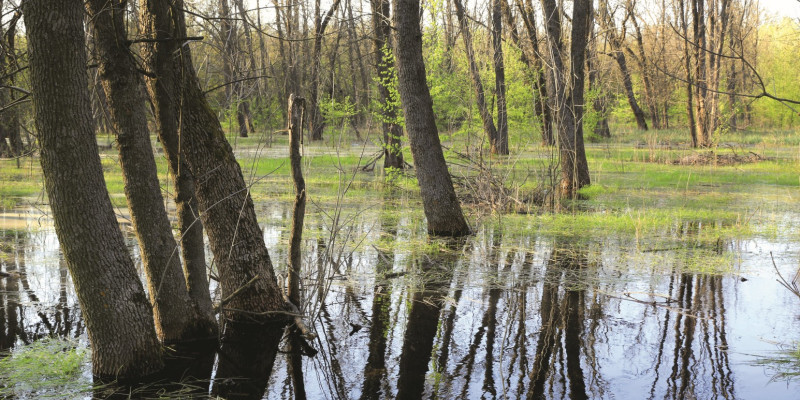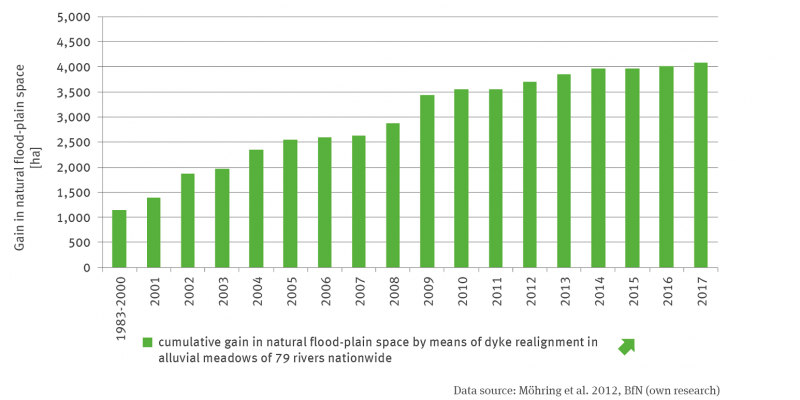BD-I-3: Restoration of natural flood-plains
 Click to enlarge
Click to enlargeSource: Photograph: © Pavel Klimenko / stock.adobe.com

2019 Monitoring Report on the German Strategy for Adaptation to Climate Change
 Umweltbundesamt
Umweltbundesamt
 Click to enlarge
Click to enlarge
2019 Monitoring Report on the German Strategy for Adaptation to Climate Change
The relocation, renaturation or slotting of dykes carried out since 1983 has produced an increase in natural flood-plains. By their connection to water courses or water bodies and by restoring the dynamics of natural flooding, new and – in terms of nature conservation – valuable habitats have been created for numerous rare and endangered animal and plant species. Likewise, alluvial forests have been created which are just as important in terms of nature conservation.

The bar chart represents the reclamation of natural floodplains through dike relocation from 1983/2000 to 2017. For 2017, a cumulative area of about more than 4000 hectares is shown. The time series shows a significantly increasing trend.
Apart from direct impacts on biodiversity as described above, climate change and the associated climate protection and adaptation measures also cause indirect impacts, above all in terms of changed land use. As estimated by experts these indirect impacts from climate change influence the development of biodiversity even more strongly than direct impacts from changing climatic conditions. Owing to the complex interaction of various factors of influence it would be hardly possible, for the time being, to attempt an exact quantification of indirect impacts of climate protection and adaptation measures in respect of species and habitats.
The changes in land use which can be attributed to climate change also include adaptation measures in respect of the development of water bodies, water courses and alluvial meadows. Apart from heightening dykes, the installation of holding ponds or other technically-based measures, the durable restoration of natural flood plains is considered an effective component of comprehensive floodwater risk management.
Where rivers can spread into such flood-plains in case of floodwater events, run-off is slowed down and the floodwater wave attenuated. Such newly gained flood-plains were in many cases under intensive agricultural use. Where areas are exposed to natural floodwater dynamics, they can be re-colonised by many species of plants and animals typical of alluvial meadow habitats. This includes numerous rare and endangered species which are adapted to the special conditions of heavily alternating water levels, such as beaver, otter, kingfisher, sand-martin, marsh harrier, various species of duck – especially those sensitive to disturbance – as well as numerous species of dragonfly and amphibians. Besides, habitats that can flood naturally such as alluvial meadows, serve as important links in biotope networks and within the system of protected areas designated under Natura 2000.
The renaturation of dykes for the purpose of restoring natural retention areas in alluvial river meadows shows that measures for adaptation to climate change taken within the framework of nature-compatible flood-water protection can also have beneficial impacts on biodiversity.
By means of renaturation, relocation or slotting of dykes in respect of 79 rivers nationwide, an area of 4,080 hectares of former alluvial meadows was, in the period from 1983 to 2017, reconnected with the natural flooding dynamics of water courses. As a result they are, during floodwater events, flooded without any human intervention or control. The installation of controlled flood-water polders or some other type of controlled flooding of alluvial meadows have not been taken into consideration. The annual net gain depends on the size of completed projects in the year concerned which makes this figure highly variable. Only comparatively small areas were gained in the period from 2014 to 2017.
It has to be said that, as a rule, measures for the purpose of regaining natural flood-plains were not taken exclusively or primarily for the adaptation to climate change. Nevertheless, the past 15 years have demonstrated increased awareness that climate change entails changes in the run-off dynamics of river catchment areas, which require the restoration of natural retention areas in order to prevent flood-water damage, e.g. to residential areas, transport infrastructure or agricultural land.
In 2009 a nationwide inventory of alluvial meadows was made which showed that of formerly approx. 1.5 million hectares of alluvial meadowland on riversides, only approx. 480,000 hectares remain available as retention areas for floodwater.36 Compared to those figures, the regaining of naturally flooded alluvial meadow areas in the period from 1983 to 2017 is a relatively small area.
36 - BMU & BfN (Hrsg.) 2009: Auenzustandsbericht – Flussauen in Deutschland. Berlin, Bonn, 34 S.
WW-R-3: Riparian vegetation on the banks of small and medium-sized watercourses - case study
RO-R-3: Priority and restricted areas for (preventive) flood control
Extending retention areas on riversides by at least 10 % by 2020 (NBS, ch. B 1.2.4)
Former flood-plains suitable as retention areas should be restored as far as possible unless counter-indicated by overriding interests of the common good (WHG, § 77 (2))
Promoting measures with moderating effects on extreme events, e.g. for improving the hydromorphology (including the reconnection of oxbow lakes, but also the relocation of dykes) (DAS, ch. 2.3)